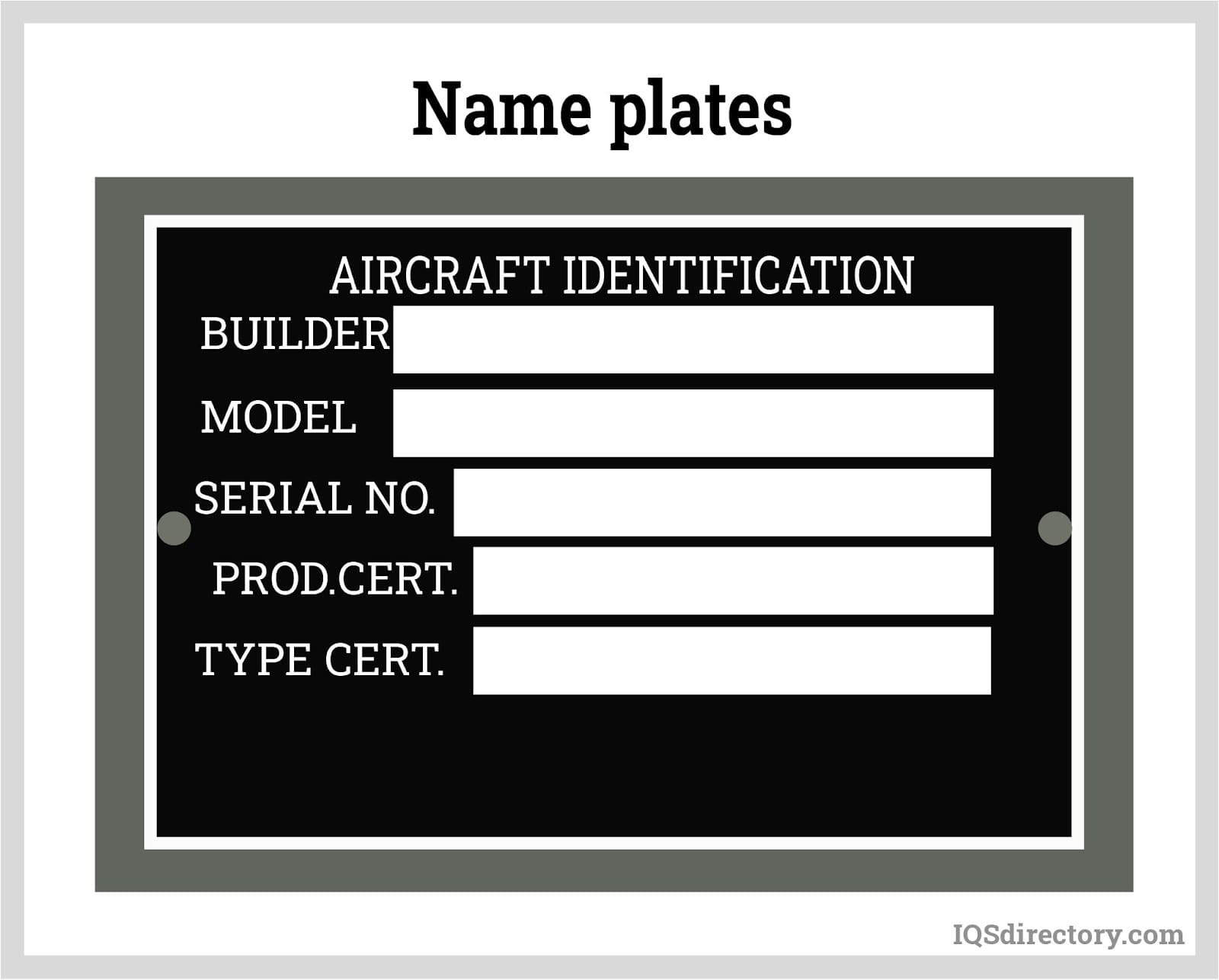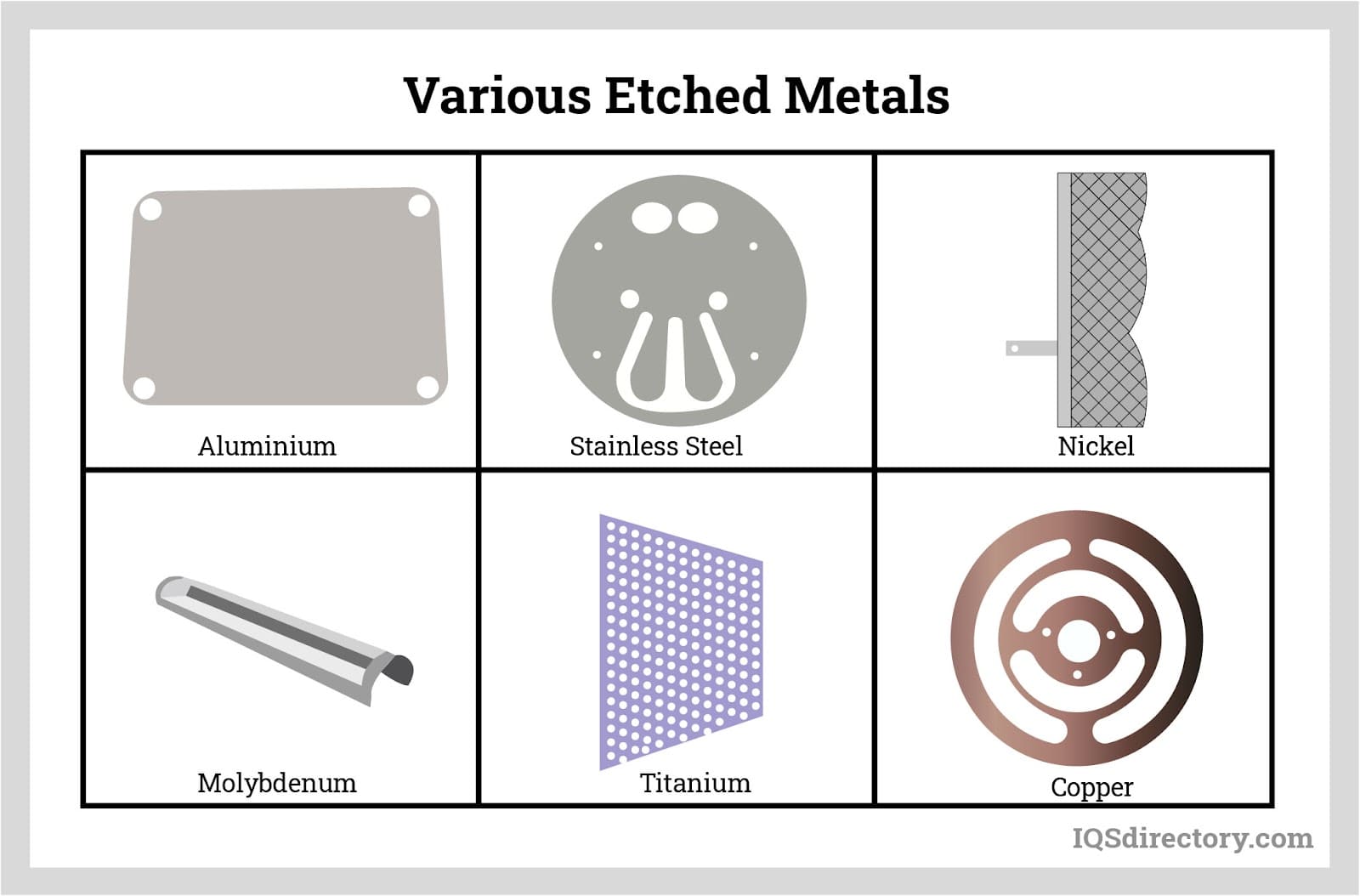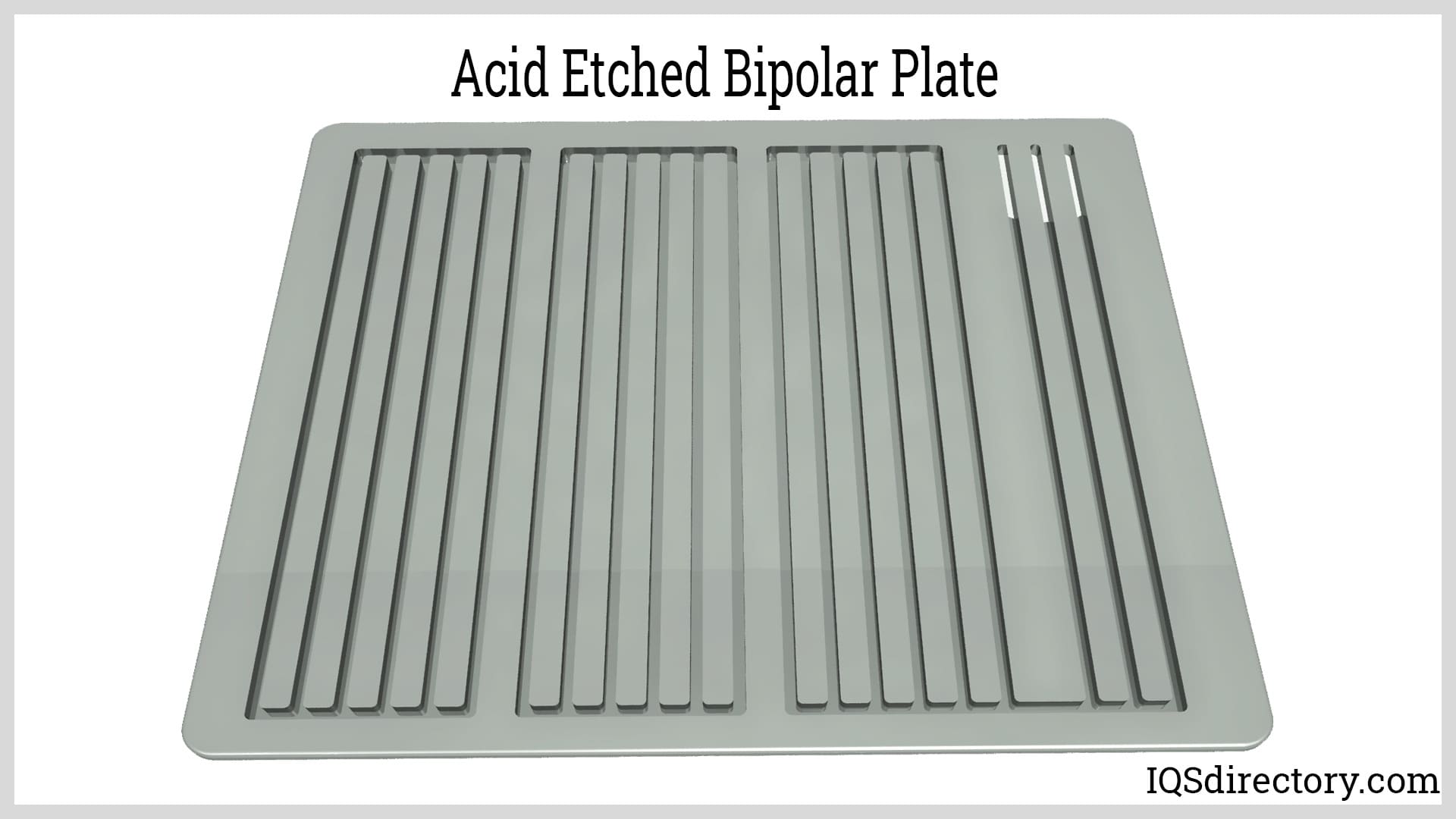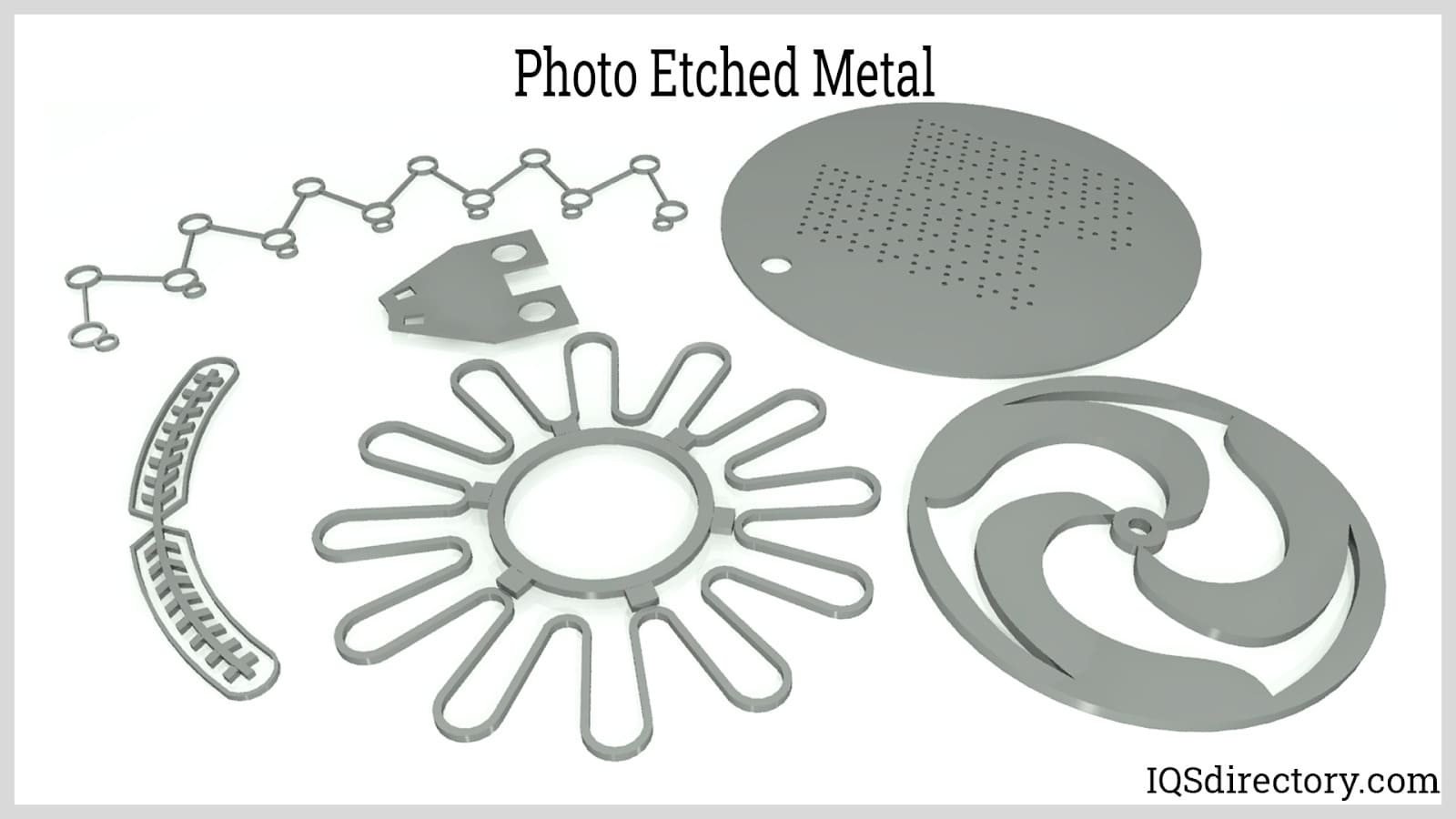Metal Etching
Metal etching, also known as metal engraving, is the method of producing grooves, fine lines, or detailed patterns on metal parts or sheets. This process serves a wide range of purposes, including decorative, industrial, and architectural applications. Industries that utilize metal etching include jewelry, furniture, architecture, music, art, healthcare, woodworking, aerospace, electronics, and the defense sector. For example, manufacturers may use decorative etching to darken surfaces, making etched lines more prominent. Additionally, metal etching allows parts to meet strict weight requirements by removing a thin layer through chemical or mechanical processes.
Metal Etching FAQs
What industries commonly use metal etching?
Metal etching is widely used in aerospace, defense, electronics, healthcare, jewelry, architecture, furniture, and musical instrument manufacturing, offering both functional and decorative applications across these industries.
How does the metal etching process work?
The process begins with cleaning the surface, applying a chemical-resistant mask, immersing the metal in an etchant to remove material, and finally removing the mask to reveal precise grooves or patterns.
What are the main advantages of metal etching?
Metal etching offers speed, precision, and compatibility with many materials. It avoids deformation, internal stress, and burrs, while preserving hardness and minimizing the need for secondary finishing or tooling.
What materials can be processed with metal etching?
Common metals include aluminum, brass, copper, stainless steel, nickel, and carbon steel. The process adapts to nearly all metals using chemical milling, photochemical etching, or mechanical methods.
What are the main types of metal etching methods?
Methods include acid etching, chemical milling, photochemical machining, laser etching, electroetching, abrasive blasting, and dry plasma-based etching. Each is selected based on material, precision, and design needs.
What factors influence the depth of a metal etch?
Depth depends on exposure time, material type, etchant concentration, and bath temperature. Test runs are often performed to adjust these variables and achieve precise results.
Why is photochemical machining important in modern manufacturing?
Photochemical machining enables intricate, burr-free designs without stressing the material. It supports micro-fabrication for electronics, aerospace, and defense, making it vital for high-precision parts.
History of Metal Etching
The etching process, with few changes over centuries, has been applied across diverse industries including micro-electromechanical systems, aerospace, circuit printing, and missile production. Despite its advanced applications today, the technology originated in ancient times.
Early on, etching was developed for artistic purposes, especially on soft metals like copper and zinc, and later on harder metals such as steel, using strong acids. Armor, firearms, plates, and cups were commonly etched for decorative enhancement.
- Progression of Etching
- By the 16th century, etching had a significant impact on printmaking in Germany. In this process, a metal plate was coated in an acid-resistant material, such as wax. Artists would scrape away the wax to reveal the metal, using a pointed etching needle to create a design. The plate was then immersed in acid, which etched the exposed metal to create sunken lines and images. Afterward, the plates were inked and used for printing, helping to fuel the printing revolution and lead Europe into the industrial era.
- During this period, the metal etch process emerged as an alternative to metal engraving, which was a common method for patterning metal. Chemical etching became popular for marking artillery and cannons with trajectory data, since etched markings were highly durable. Milling and etching were also applied to tools, daggers, and shovels.
- A major advancement in metal etching occurred in the 18th century when Swiss botanist John Senebier discovered that certain plant resins, once exposed to light, hardened and became insoluble in turpentine. This finding played a key role in the development of photochemical etching, although the technique was initially used only in photography. A light-resistant resin would be applied to the metal, exposed to light to define the pattern, and then used to produce impressions on metal plates.
- During the 1900s
- Modern photochemical machining began in 1927 when Aktiebolaget Separator, a Swedish company, developed and patented this process for making edge filters. The method gained wider use during World War II, allowing for the etching of hard metals from both sides and facilitating the production of sheet foil components. Advances in etching technology later enabled micro-fabrication, supporting the growth of the information technology industry.
Regardless of the chosen method, metal etching provides many benefits compared to other machining processes. Whether for stencils, metal stamps, or semiconductor production, metal etching is highly versatile and widely applicable.
One key benefit is compatibility with a wide range of materials, including both hard metals and soft plastics. Additionally, it does not cause deformation or internal stress, nor does it produce debris or burrs. As a result, parts made by metal etching usually require minimal secondary finishing or additional tooling.
Furthermore, the process preserves the original material properties, such as hardness. Metal etching is also valued for its speed and precision, and manufacturers can easily modify designs as needed. Another advantage is that it eliminates the need for hard tooling.
In metal etching, cuts of different depths are achieved, with the depth determined by how long the metal is exposed to the etchant bath. The etching rate is calculated based on the ratio of depth to time spent in the bath.
Many variables affect the etch rate, including the type of material, bath temperature, and the composition and concentration of the etchant. Due to these factors, it is common practice to conduct test runs, where the material is exposed to chemicals and monitored for results. The process and chemistry are adjusted as needed to achieve the desired depth and rate.
What is a standard metal etching process?
- Cleaning Surfaces
- The process begins with surface cleaning to prepare the metal for etching. It is essential to remove all contaminants, as they can interfere with the etching reaction and cause uneven results. Solvents, including de-oxidizing and alkaline solutions, are commonly used to clean the metal. Typical contaminants are grease, primer, marking residues, and oils.
- Applying Masking Agent
- In industrial applications, maskants such as isobutylene-isoprene copolymers and neoprene elastomers are applied because they resist chemical reactions. The masking material is patterned onto the surface to outline the desired design, either by dipping or flow coating. In dip masking, parts are submerged in maskant, while flow coating applies the maskant over the surface.
- Immersion in Etchant
- At this stage, the actual metal etching occurs. The masked metal parts are immersed in a chemical solution, such as ferric chloride, for a specific period to achieve the required width and depth. Several factors influence the outcome, as previously described.
- Removing the Mask
- In the final step, known as demasking, both the reaction by-products and maskant are removed to reveal the finished pattern. Cold water or specialized de-oxidizing baths are used to eliminate chemical residues. Various methods, often manual scraping, are used to remove the maskant from the part.
 Metal etching removes metal using different methods to configure complex, intricate, and highly accurate shapes.
Metal etching removes metal using different methods to configure complex, intricate, and highly accurate shapes.
 The different types of metals are affected differently by the etching process.
The different types of metals are affected differently by the etching process.
 Acid etching, a chemical process where a strong acid is applied to a piece of metal to remove a segment of the metal’s surface to create a design or component.
Acid etching, a chemical process where a strong acid is applied to a piece of metal to remove a segment of the metal’s surface to create a design or component.
 Photochemical etching, uses photographic and chemical techniques in order to shape the metal.
Photochemical etching, uses photographic and chemical techniques in order to shape the metal.
- Abrasive Etching
- The process of using controlled, high-pressure compressed air to direct an abrasive, such as sand or aluminum oxide, at the surface of a material to create the etched effect.
- Acid Etching
- Uses acid to engrave the surface of sheet metal.
- Aluminum Etching
- Used to create aluminum industrial parts that require many small grooves or holes, or a decorative finish.
- Brass Etching
- Used to create brass industrial parts that require many small grooves or holes, or a decorative finish.
- Chemical Etching
- Uses acids, bases, and other chemicals to etch into the surface of metal.
- Chemical Machining
- Used in many metal manufacturing industries to etch, cut or engrave metal plates in a number of capacities as it provides delicate and precise design capabilities.
- Chemical Milling
- A chemical process used by many industrial metal parts manufacturers to etch, cut, or engrave extremely delicate or precise lines into metal.
- Copper Etching
- Used to create copper industrial parts that require many small grooves or holes, or a decorative finish.
- Dry Etching
- Any etching process that does not employ the use of chemicals.
- Electroetching
- An etching process that involves the use of chemicals, along with the employment of direct electric current.
- Laser Etching
- Employs the use of a laser for the removal of a specified pattern on a metal piece. Laser etching is often used in the jewelry industry.
- Metal Engravers
- Metal tools used to carve designs into metal surfaces.
- Metal Engraving
- The process by which metal tools are employed to carve a design into metal.
- Photo Engraving
- Uses photosensitive material that is resistant to acid and applies it to the surface of a metal sheet. Acid is then applied, creating an image by burning through the areas where the acid-resistant material is missing.
- Photo Etching
- The most common metal etching process and otherwise referred to as "metal chemical etching," "chemical milling," "photochemical etching," "chemical etching" or "photochemical machining," is the process in which a desired image is etched on the surface of the metal part via a photosensitive template. The piece is then exposed to an appropriate acid (or etchant) that removes a layer of metal in areas left unprotected by the template, after which the piece is cleaned and the photoresist template removed.
- Photofabrication
- Combines photographic processes and materials with chemical machining to etch, cut or engrave metal parts for a variety of industries.
- Reactive Ion Etching (REI)
- Also known as "plasma etching," is a dry etching technique. REI involves the use of electrical circuits and high-energy gas made up of ionized particles containing fluorine or chlorine.
- Sputter Etching
- A type of REI etching but without the employment of ions.
- Stainless Steel Etching
- Used to create stainless steel industrial parts that require many small grooves or holes, or a decorative finish.
- Vapor Phase Etching
- A dry etch technique that uses reactive gases to achieve the desired etching pattern.
Metal etching is a highly adaptable process; nearly all metals can be processed using chemical milling, photo engraving, or mechanical etching. Common materials include aluminum, brass, copper, beryllium copper, nickel, nickel silver, carbon steel, and stainless steel.
Frequently used corrosive chemicals, or etchants, in these processes include ferric chloride (optimal for copper or zinc), ferric nitrate, nitric acid (best for zinc or steel), copper sulfate, hydrochloric acid, citric acid, nitroxyl (HNO), and phosphoric acid.
Machinery Used with Etching
Manufacturers utilize various machines to achieve precise cuts and patterns during metal etching.
Milling and grinding machines are often used to create specific etched finishes, especially on large metal sheets for decorative architectural or furniture applications.
Lathes and CNC machines with fine tips are used to process different materials and shapes, including both straight and curved surfaces.
For detailed or small-scale work, such as jewelry, firearms, musical instruments, or fine decorative pieces, hand engraving tools are still employed.
Modern engraving machines are user-friendly and can engrave on metals, glass, or plastics. These machines typically consist of a stylus or marking tool, a controller, and a work surface. Diamond styluses are commonly used for engraving harder materials and metals.
If you are determining whether metal etching is the right solution for your needs, consider your specific requirements and whether they align with the capabilities of metal etching. Think about the level of design precision you need, your industry's standards, and the required depth or thickness of cuts.
The best way to make an informed choice is to consult with a qualified manufacturer. Look for manufacturers who are experienced, attentive to your project vision, mindful of your budget, and able to deliver within your timeline. Start your search by reaching out to the companies listed above and ask them questions to see if they are a good fit.
Widely used metal etching methods include laser etching, electro discharge machining, chemical milling (chemical machining), acid etching (photochemical etching), mechanical milling, as well as wet and dry etching. Manufacturers may also use techniques like stamping, laser engraving, or water-jet cutting on metal parts. These methods are generally faster and more precise than hand engraving.
- Laser Etching
- Able to create very fine, clean lines in surfaces with little need for secondary finishing.
- Electro Discharge Machining (EDM)
- Another method of metal etching which is able to achieve close tolerances. During the process, the metal part is exposed to streams of corrosive electromagnetic discharge. Any resulting imperfections, burrs or marks may be smoothed and polished away after you etch the metal.
- Chemical Milling/Chemical Machining
- Manufacturers begin the chemical milling process, also known as chemical machining or photochemical milling, by taking a piece of metal sheet and covering it in a masking compound. The masking compound, which is inert, protects, or masks, the covered material from the etchant. Manufacturers choose what they cover carefully, in order to achieve the shape and cuts they desire. Once this is done, they bathe the metal in the etchant of their choice. The etchant chemically reacts with the exposed material, and cuts it via dissolution.
- Acid Etching
- Very similar to chemical milling. Manufacturers use this method to create grooves, images, lines and holed surfaces. When they etch with acid, they are able to achieve precise lines and specific depths. They begin the process by stripping the sheet metal they plan to etch of all oils and chemicals. They first strip organic matter, using cleansers such as alkaline cleaners, then remove chemical residue by using an acid cleaner. Note: neither of these cleansers can be too strong, or the polished surface of the metal will be scratched.
- Next, they apply a maskant to the entire surface. In this case, they usually use masking types such as tapes, paints, elastomers (rubber) or plastics. They cut a pattern into the masking in the same shape the metal is to be cut, then remove the masking from the areas they will etch. After that, they apply the chemical, or "reagent."
- Finally, after the acid has achieved its desired etch, manufacturers strip both the reagent and the remaining maskant from the metal part to reveal the final design. The length of time they let a chemical react with a metal part depends on the desired depth of the grooves, and the strength of the acid.
- Photochemical Machining
- To start the photochemical machining process, manufacturers print the desired shape of the product onto photographic film. Then, they select a metal material, cut it down to size, coat it in photoresist, place it between two sheets of film and vacuum seal them together. After that, they expose the plate to a UV light that causes the photoresist to harden. Once it’s ready, manufacturers wash away the extra photoresist, leaving only the areas they plan to etch. After this, they add the etchant, which rapidly eats away at the exposed metal. After it’s been sufficiently etched, they neutralize the etchant and rinse it away, leaving behind a finished part.
- Mechanical Milling
- A common method used to metal etch, uses a lathe or CNC machine with fine tips which are able to process a range of materials and dimensions, including straight or curved surfaces. The computer of these machines controls the laser's or cutter's direction, pressure and speed resulting in a precise image or design with clean, fine lines. This method achieves precise and consistent results, but the initial tooling costs are high, and maintenance of the machines requires qualified personnel.
In addition, metal etching processes are generally categorized into wet and dry etching.
Depending on the desired configuration, manufacturers use either wet or dry metal etching based on the type of etchant employed. Chemical etching is similar to chemical milling, but chemical milling allows for greater depth and etch rate.
Etching can be isotropic or anisotropic.
- Isotropic
- When an etchant removes material in all directions uniformly.
- Anisotropic
- When an etchant removes material in a vertical direction.
Anisotropic etching may be fully or partially directional. Dry anisotropic etching typically achieves higher aspect ratios and finer resolution than isotropic etching.
- Wet Etching
- When an etchant is in liquid form, the metal etching is called wet. The patterns that are required to be saved are masked, and the exposed material is etched away by liquid etchant. Lithography is used before the fabrication step to mask the patterns and configuration.
- In wet etching, multiple chemical reactions take place, as the original reactants are consumed and new reactants are produced.
- The wet etching process can be simplified in three steps:
- In the first step, the liquid etchant fuses on to the structure that needs to be removed.
- In the second step, the liquid etchant and the material react and the material is etched away. The reaction is typically reduction-oxidation, where the target material is oxidized and dissolves.
- The third step is the diffusion of by-products.
- When Silicon is used to etch anisotropic shapes, the common wet etch agents include ethylenediamine pyrocatechol (EDP), potassium hydroxide (KOH), and tetramethylammonium hydroxide (TMAH). However, in isotropic wet etching using Silicon, manufacturers use acetic acid, nitric acid, and hydrofluoric acid in combination. The rate of etching is defined by the concentration of etchants.
- Dry Etching
- To achieve a dry metal etch, instead of a solution, plasma or gas is employed to remove the material. The kinetic energy of particle beams, which is usually high, and the chemical reaction, or the combinations of these, etch the material.
- Dry metal etching is further categorized as physical or chemical based. In physical dry etching, the kinetic energy of ions, electrons, or photons etch the substrate. In this type of etching, no chemical reaction is involved and particles kick the atoms out while the material evaporates.
- Chemical dry etching or vapor phase etching, as their names imply, involve chemical reactions to attack a silicon surface. The chemicals that are usually utilized for dry etch are fluorine, tetrafluoro methane, nitrogen trifluoride, sulfur hexafluoride, and chlorine gas.
- As mentioned before, physical and chemical metal etching can also be in a combination and is called reactive ion etching. The reactive ion etching is the most extensively used technique in industrial settings as well as in labs. As both actions are used, the etch process is more rapid than normal. The process involves positively charged ions, which are produced from the reactive gases. The cations are exposed to the substrate at high speed, which then react chemically with the silicon.
- Acid
- A substance that, when dissolved in water, forms a solution with a pH of less than seven.
- Bend Lines
- Lines that are partially etched into the surface of the metal, which aid in the bending of the part in a subsequent operation.
- Burn-In
- The process of heating a developed photoresist image until the resist coating becomes chemically resistant.
- Chemical Blanking
- A term originally used to refer to the process of photo chemical machining (PCM).
- Chlorine Regeneration
- A process in which ferric chloride acid is regenerated to maintain high quality acid for the etching process.
- Coating
- The dipping, rolling, spraying, laminating, spinning, printing or flowing of the substrate surface layer of a photoresist material in order to cover it with a resist.
- Contact Printing
- A photographic process in which an image is transferred from one substrate to another.
- Conversion Coating
- The subjection of a substrate surface to high temperatures or the pickling process in order to improve photo resistant adhesion.
- Dry Film Resist
- Photoresist in the form of rolled sheet laminate.
- Etch Band Design
- Designing artwork for parts to be photochemically machined so that all shapes are outlined with a controlled line to be etched.
- Etchant
- An acid used to dissolve a layer of metal to form the component.
- Fret
- A series of etched parts that are tagged into a frame. Blanks usually have several frets etched into them.
- Halogen
- Non-metallic elements fluorine, chlorine, bromine and iodine.
- Intaglio
- An image etched/sunk into the surface of a piece.
- Ion
- An electrically charged atom or group of atoms, the electrical charge of which results from a neutral atom or group of atoms losing or gaining one or more electrons.
- Liquid Resist
- A photoresist applied to the substrate by dipping, roller coating or spraying.
- Photodiode
- A device that receives optical power and changes it into an electrical signal.
- Photoresist
- A material that, when applied to any of a variety of substances, becomes sensitive to portions of the electromagnetic spectrum and, when properly exposed and developed, masks a portion of the material.
- Photo Etched Parts
- A process which uses chemicals and precise light exposure to create all kinds of metal parts. Photo etching goes by several other names, including chemical etching, chemical milling, photochemical machining, chemical machining and chemical etching.
- Spectral Sensitivity
- The rate of response of a photographic material to a particular range of the electromagnetic spectrum.
- Substrate
- A structure that underlies and supports or forms base material on which coatings are applied.
- Ultraviolet (UV)
- Invisible electromagnetic radiation.